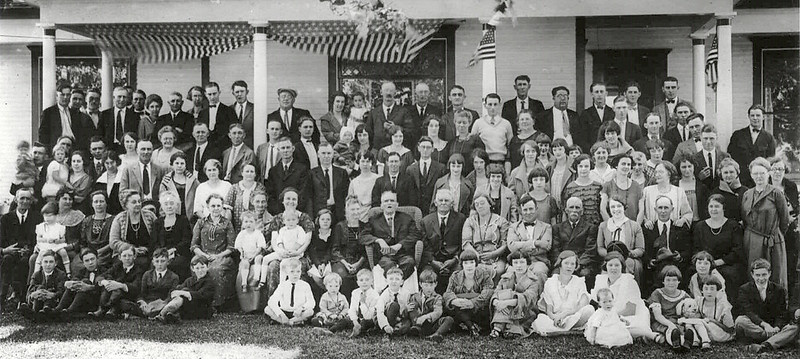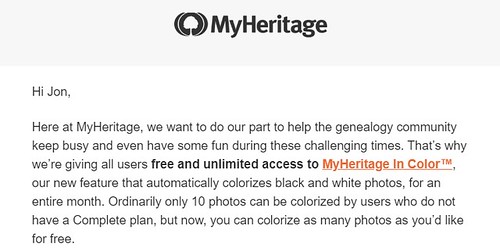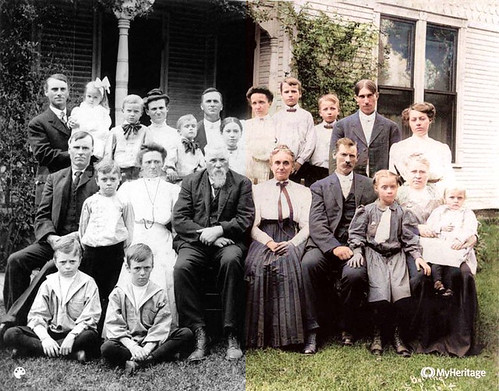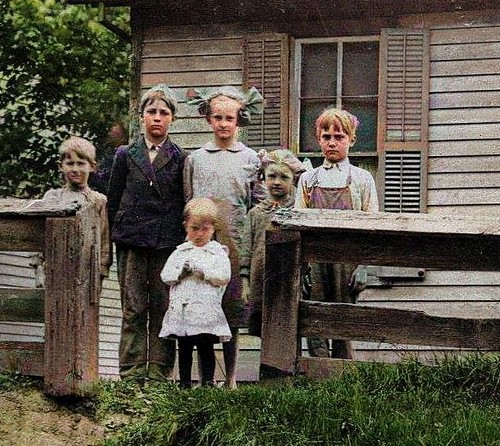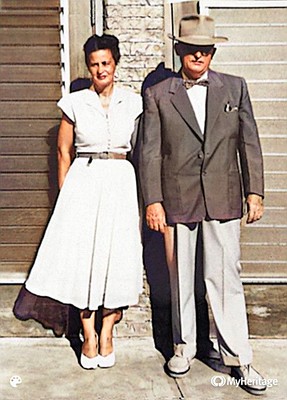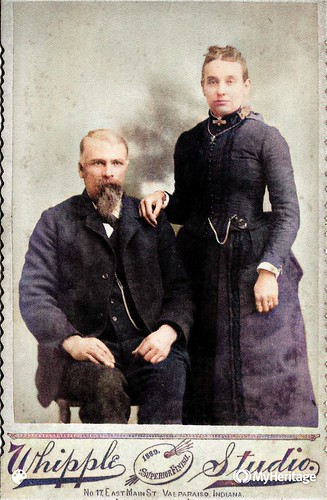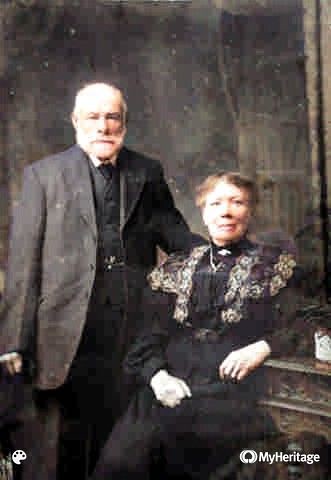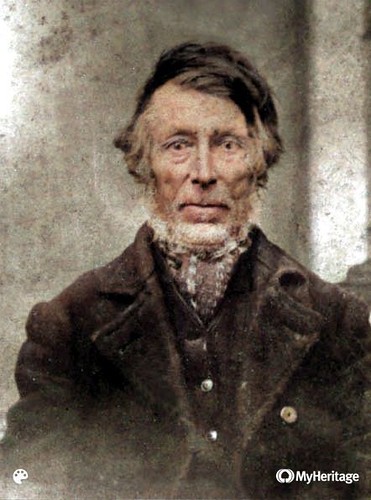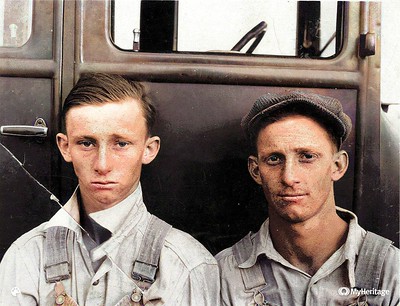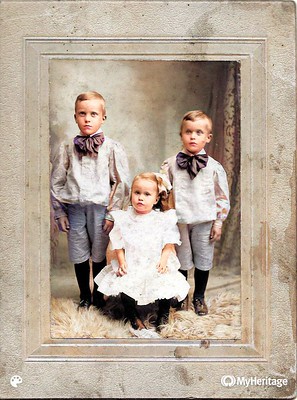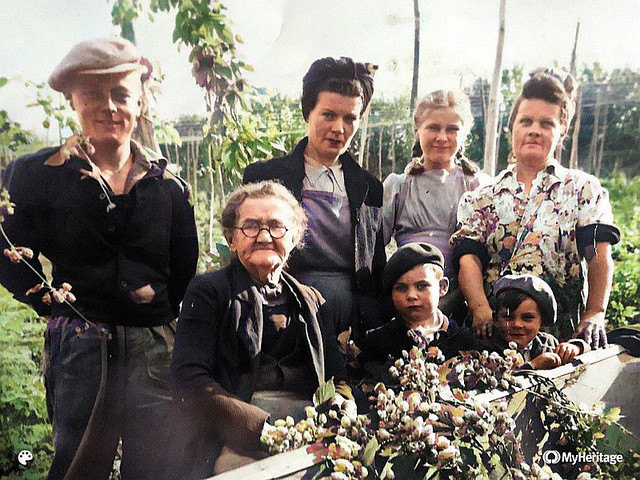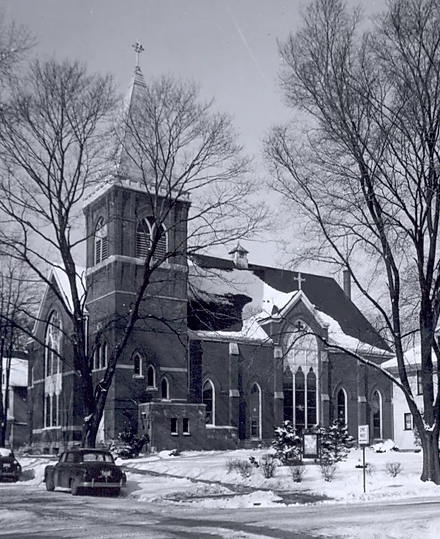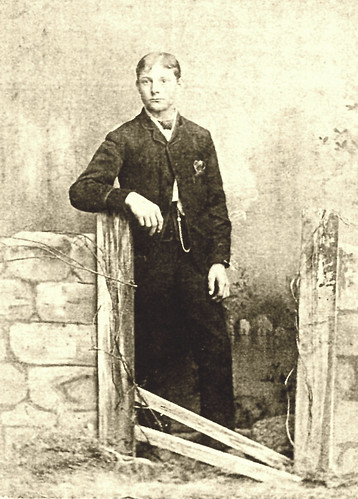Slocum … I’ve heard that name before; I wonder if she’s related?
Today’s post is an outgrowth of the two previous posts, in which I explored the connections between the Casbon and Aylesworth family trees. While conducting my Aylesworth research, I came upon the name of Martha Slocum, who married Philip Aylesworth, a member of the fourth generation of his family in America and a direct ancestor of many living Casbons.
The name Slocum was not new to me. William Wallace Slocum married Mary Casbon in Ohio, 1862.[1] After Mary died, he married Emma Payne in 1865 (see “From England to America, Part 8”).[2] Mary Casbon was the niece of Thomas Casbon, the original immigrant from England, and Emma Payne was the niece of Thomas’s wife, Emma Scruby. Emma Payne’s mother, Sarah Scruby, was married to James Payne of Meldreth, Cambridgeshire, England.
A little digging showed that Martha and William Wallace Slocum were distantly related. They were both descended from Giles Slocum ( ? –1682), who immigrated from England to Rhode Island before 1648.[3] Martha was descended from Giles’s son Samuel and William Wallace from Giles’s son Eleazar. Martha was in the fifth generation of descendants and William Wallace in the seventh.
So now I knew that the Slocum, Aylesworth, and Casbon families were all related to one another.
Furthermore, with William Wallace Slocum’s marriage to Emma Payne, the Slocums became connected to the Scruby family, who were already related to the Casbons through the marriage of Emma Scruby to Thomas Casbon and later through the marriage of Mary Payne (Emma Payne’s sister) to James Casbon.
Are you confused yet?
I decided to plot out all the ways that the Slocum, Aylesworth, Scruby (including Payne), and Casbon families were related. I added a fifth family, Priest, because I was aware of multiple connections on their part as well. Here is the result of my efforts.

Diagram depicting interconnected family trees of the Slocum (green), Aylesworth (orange), Scruby (pink), Casbon (blue) and Priest (yellow) families. Superscript numbers denote generations, with “1” depicting either the original immigrant (Slocum and Aylesworth) or the common ancestor (Scruby, Casbon, and Priest); colored lines indicate parent-child relationships and arrows depict direct descent through multiple generations; marriages are connected by black lines (Click on image to enlarge)
You’ll need to enlarge the diagram to see details.
As the title suggests, these five families are connected to each other through eleven marriages. Here is a summary of the connections for each family:
- Slocum:
– Connected to Aylesworth through the marriage of Martha5 Slocum to Philip4 Aylesworth, 1762[4]
– Connected to Casbon through the marriage of William Wallace7 Slocum to Mary3 Casbon, 1862
– Connected to Scruby through the marriage of William Wallace7 Slocum to Emma3 Payne, 1865 - Aylesworth:
– Connected to Slocum through the marriage of Philip4 Aylesworth to Martha5 Slocum, as above
– Connected to Casbon through the marriages of Mary Adaline7 Aylesworth to Sylvester3 Casbon, 1860,[5] and Carrie Belle9 Aylesworth to Amos3 Casbon, 1900[6]
– Connected to Scruby through the marriage of Louisa8 Aylesworth to George3 Scruby, 1872[7]
– Connected to Priest through the marriage of Elliot7 Aylesworth to Caroline2 Priest, 1848[8] - Scruby:
– Connected to Slocum through the marriage of Emma3 Payne to William Wallace7 Slocum, as above
– Connected to Aylesworth through the marriage of George3 Scruby to Louisa8 Aylesworth, as above
– Connected to Casbon through the marriages of Emma2 Scruby to Thomas2 Casbon, 1830,[9] and Mary3 Payne to James2 Casbon, 1876[10]
– Connected to Priest through the marriage of James2 Scruby to Phebe2 Priest, 1824[11] - Casbon:
– Connected to Slocum through the marriage of Mary3 Casbon to William Wallace7 Slocum, as above
– Connected to Aylesworth through the marriages of Sylvester3 Casbon to Mary Adaline7 Aylesworth and Amos3 Casbon to Carrie Belle9 Aylesworth, as above
– Connected to Scruby through the marriages of Thomas2 Casbon to Emma2 Scruby and James2 Casbon to Mary3 Payne, as above
– Connected to Priest through the marriage of Mary Ann3 Casbon to Elijah2 Priest, 1853[12] - Priest:
– Connected to Aylesworth through the marriage of Caroline2 Priest to Elliot7 Aylesworth, as above
– Connected to Scruby through the marriage of Phebe2 Priest to James2 Scruby
– Connected to Casbon through the marriage of Elijah2 Priest to Mary Ann3 Casbon, as above
Three of the families—Aylesworth, Scruby, and Casbon—are connected by marriage to all four of the remaining families. The remaining two families—Slocum and Priest—are connected to three of the other four families. Of the marriages, one took place in England, one in Rhode Island, six in Ohio, and three in Indiana.
The chart shows how entangled family trees can become. I’m going to coin a new term for this. Instead of a family tree, this is a family hedge! It’s an accurate description of what we see, with branches from several families intermingling and creating complex relationships.
I suspect this occurs more often than we might realize, but we might not see it because we’re not looking for it. Have you discovered any hedges in your family history?
[1] Ohio, Huron County, Marriage Records, vol. 1 [1855–1866], p. 350; imaged as “Ohio, County Marriages, 1789–2013,” FamilySearch (https://familysearch.org/ark:/61903/1:1:XZ65-99 : accessed 21 Jul 2016) >Huron >Marriage Records 1855–1866 vol 1 >image 220 of 306.
[2] Ohio, Huron County, Marriage Records, vol. 1 [1855–1866], p. 465, no. 2779; imaged as “Ohio, County Marriages, 1789–2013,” FamilySearch (https://familysearch.org/ark:/61903/1:1:XZ65-99 : accessed 22 May 2018) >Huron >Marriage Records 1855–1866 vol 1 >image 277 of 306.
[3] “Giles Slocum (abt. 1623 – aft. 1683),” article, WikiTree (https://www.wikitree.com/wiki/Slocum-10 : accessed 9 Apr 2020).
[4] James Newell Arnold, Rhode Island Vital Extracts, 1636–1850, volume 1 (Providence, R.I.: Narragansett Historical Publishing Company, 1891), p. 4; imaged at Ancestry (https://www.ancestry.com/search/collections/3897/ : accessed 2 Apr 2020) >Vol· 01: Kent County: Births, Marriages, Deaths >image 432 of 637.
[5] Indiana, Porter County, Marriage Record Book 2 [Dec. 1850–Jun. 186], p. 458; Valparaiso (Indiana) Public Library.
[6] Indiana, Porter County, Marriage Record, vol. 12 [Nov. 1898–Oct. 1901], p. 326; browsable images, FamilySearch (https://www.familysearch.org/search/film/005014498?cat=608739 : accessed 8 Apr 2020) > Film # 005014497 >image 548 of 922.
[7] Ohio, Holmes County, Marriage Record, vol. 5 [1868–1877], p. 217; browsable images, FamilySearch (https://www.familysearch.org/search/film/004024929?cat=229343 : accessed 8 Apr 2020) > Ohio, County Marriages, 1789-2013 >Holmes >Marriage records 1868-1877 vol 5 >image 491 of 649.
[8] Ohio, Wayne County, Marriage Record, vol. 4B [1843–1851], p. 377; browsable images, FamilySearch (https://www.familysearch.org/search/film/004260649?cat=335541 : accessed 26 Aug 2016) >Film # 004260649 >image 550 of 644.
[9] Church of England, Melbourn (Cambridgeshire), Marriages, 1813–1837, p. 59, no. 175; browsable images, ” FamilySearch (https://www.familysearch.org/search/film/007549343?cat=210722 : accessed 5 Feb. 2019) >image 318 of 710.
[10] Indiana, Porter County, Marriage Record, vol. 4 [Sep. 1871–Jan. 1875], p. 348; browsable images, FamilySearch (https://www.familysearch.org/search/film/005014495?cat=608739 : accessed 8 Apr 2020) > Film # 005014494 >image 693 of 928.
[11] Ohio, Wayne County, Marriage Record, vol. 4A [1835–1843], p. 91; browsable images, FamilySearch (https://www.familysearch.org/search/film/004260649?cat=335541 : accessed 8 Apr 2020) >Film # 004260649 >image 77 of 644.
[12] Ohio, Wayne County, Marriage Record, vol. 4 (1-2) [1844–1856], p. 140; FamilySearch (https://www.familysearch.org/search/film/004260672?cat=335541 : accessed 8 Apr 2020) > Film # 004260672 >image 97 of 720.





